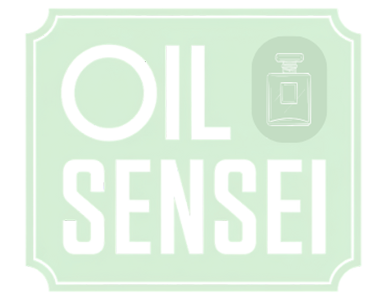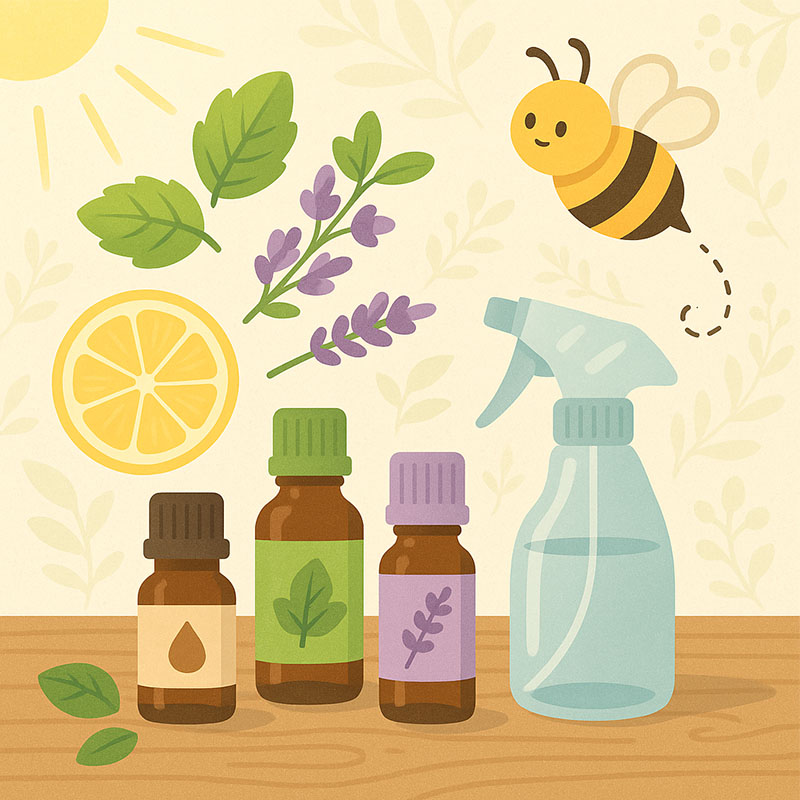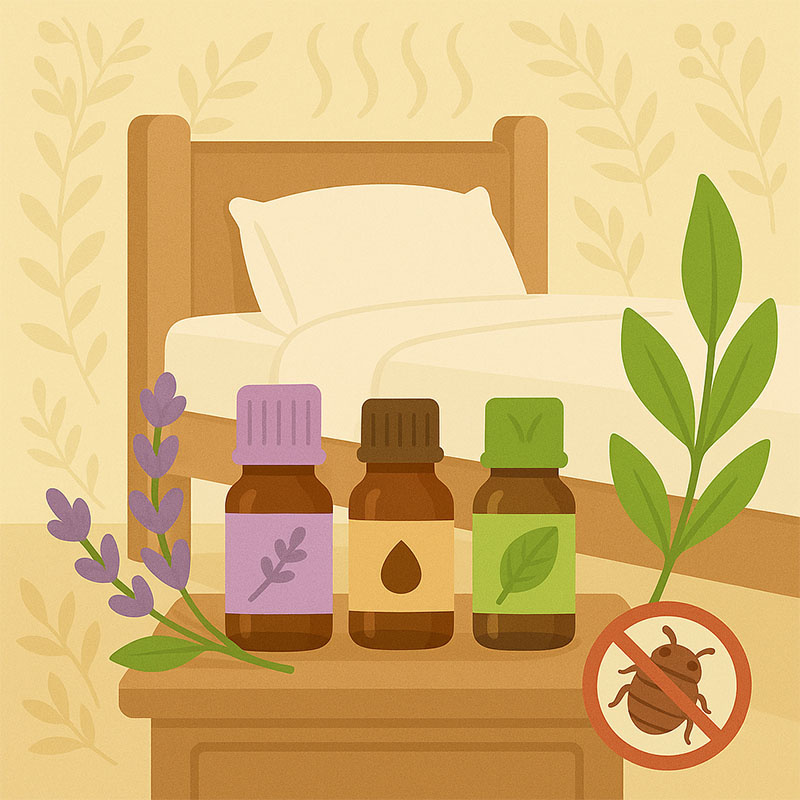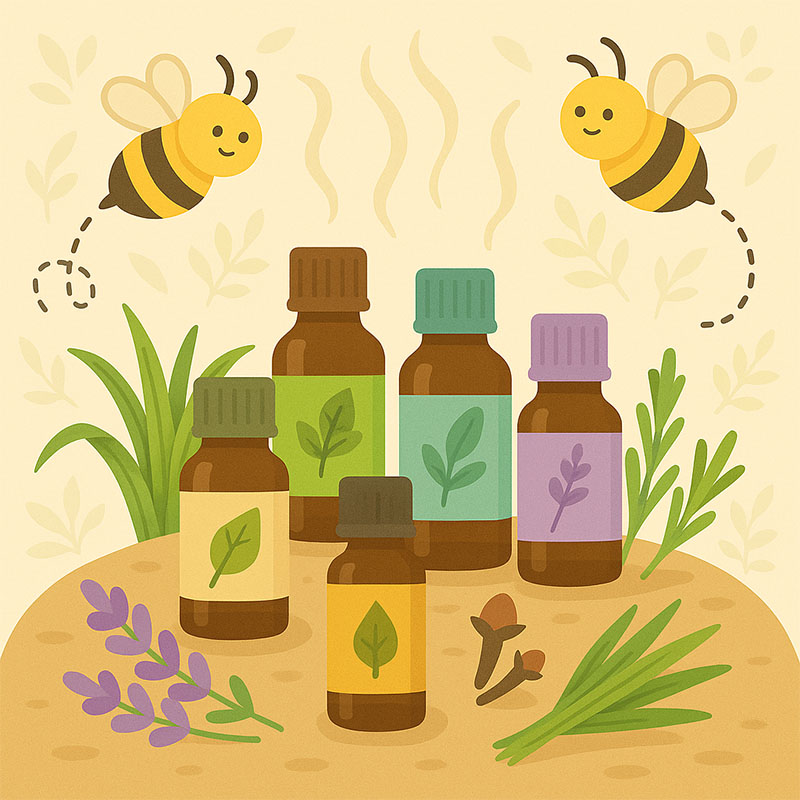I’ve always respected bees for the role they play in keeping our gardens and food supply alive. But if you’ve ever had a swarm buzzing around your patio table or hovering near a doorway, you know how uncomfortable it can feel to share that space. I’ve dealt with this on my own back deck, and instead of reaching for harsh chemical sprays, I turned to something that felt safer for me, my family, and the bees themselves: essential oils.
Over the years, I’ve tested different oils around my home to see which ones really keep bees at a comfortable distance without harming them. What I’ve learned is that certain strong aromas—like peppermint, citronella, and clove—act as natural deterrents. The good news? Most of these oils are simple to use, pleasant for us, and gentle on the environment.
Why I Use Essential Oils as Bee Repellents
For me, essential oils hit the sweet spot between effectiveness and peace of mind. Here’s why I stick with them over conventional sprays:
- Non-toxic and eco-friendly – I never wanted to risk hurting pollinators or spraying chemicals where my kids or pets spend time. Oils give me that safer alternative.
- Safe for bees – The goal isn’t to kill bees; it’s just to redirect them. Oils work more like a “keep out” sign than a weapon.
- Enjoyable scents – While bees dislike the intensity, I actually enjoy the fresh, clean atmosphere oils create around my patio or kitchen.
- Versatile – From sprays to cotton balls, candles, or even planting certain herbs, there are plenty of easy ways to use them.
Best Essential Oils To Repel Bees at a Glance
| Essential Oil | Scent Profile | Best Application | Safe for Bees | My Notes |
|---|---|---|---|---|
| Citronella | Sharp, lemon-like | Sprays, candles, planting | ✅ | My go-to for outdoor evenings. |
| Peppermint | Cool, menthol | Sprays, cotton balls | ✅ | Works best at entry points. |
| Clove | Warm, spicy | Sprays, cotton pads | ✅ | Strong scent—less is more. |
| Lavender | Floral, calming | Sachets, sprays | ✅ | Relaxing for me, discouraging for bees. |
| Eucalyptus | Medicinal, earthy | Sprays, planting | ✅ | Great for gardens and other bugs too. |
| Tea Tree | Sharp, medicinal | Sprays, diffusers | ✅ | Works, but not safe around pets. |
Top Essential Oils I’ve Used to Repel Bees
Not all oils are equally effective at keeping bees away. Some work better outdoors, others indoors, and a few smell amazing to me but are downright unpleasant for bees. Here are the oils that have made the biggest difference in my own trials:
Citronella Oil
Citronella is probably the first oil most people think of for bug control, and for good reason. I’ve used it on summer evenings when I want to sit outside without being swarmed. Its sharp, lemony aroma makes bees (and plenty of other insects) back off quickly.
👉 Citronella Essential Oil on Amazon – This one comes in a dark glass bottle with a dropper, which makes it easy to measure out for sprays.
How I use it:
- Add 10–15 drops to a spray bottle with a cup of water and mist around doors, patio chairs, or the grill area.
- Light citronella candles on outdoor tables for a comfortable, bee-free zone.
- Plant citronella in the garden for a natural layer of defense (though the oil itself is stronger).
Peppermint Oil
Peppermint has been one of my most reliable allies. The menthol scent is refreshing to me, but overwhelming for bees. I especially like using peppermint oil when bees keep hovering around doorways or vents.
👉 Peppermint Essential Oil on Amazon – A budget-friendly option that’s pure and strong enough for sprays.
How I use it:
- Mix 10 drops peppermint oil in water for a spray on furniture or entryways.
- Soak cotton balls in peppermint oil and place them near windowsills or cracks.
- Refresh every couple of days, since the scent fades quickly.
Clove Oil
Clove has a bold, spicy aroma that I personally find comforting in small doses. Bees, on the other hand, really don’t care for it. I usually pair clove with peppermint or citronella when I need something a little stronger.
👉 Clove Essential Oil on Amazon – I like this brand because it’s GC/MS-tested for purity, which gives me peace of mind.
How I use it:
- Spray 10–12 drops per cup of water around problem areas.
- Place a clove-soaked cotton pad near seating areas or entry points.
- Use sparingly—the scent is very strong.
Lavender Oil
Lavender is a funny one. Bees actually love lavender flowers in the garden, but concentrated lavender oil is a whole different story. The aroma becomes much stronger, and I’ve found it works as a gentle deterrent when used the right way.
👉 Lavender Essential Oil on Amazon – This is one of my favorites because it’s versatile enough for relaxation and bug repellent.
How I use it:
- Fill sachets with dried lavender and leave them near doors or windows.
- Make a spray with 10–15 drops lavender oil in water for porch railings or benches.
- Bonus: lavender helps me relax while discouraging bees.
Eucalyptus Oil
Eucalyptus has a strong, medicinal scent—one that bees clearly dislike. I’ve used it outdoors when I wanted a longer-lasting barrier around my deck.
👉 Eucalyptus Essential Oil on Amazon – This one comes in a larger bottle, which is great because I go through it quickly in summer.
How I use it:
- Mix 10 drops eucalyptus oil in water and spray around garden furniture or entryways.
- Plant eucalyptus shrubs or trees in sunny spots for a natural deterrent.
- Works on other insects too, not just bees.
Tea Tree Oil
Tea tree oil has been part of my natural toolkit for years because of its fresh, medicinal smell and antibacterial qualities. It’s not my first choice for repelling bees, but it works well when I rotate scents so they don’t get used to just one.
👉 Tea Tree Essential Oil on Amazon – A high-quality option that lasts a long time since I use it sparingly.
How I use it:
- Mix 10–12 drops in water and spray around patios or window frames.
- Diffuse indoors to freshen the air and make the space less attractive to bees.
- A word of caution: tea tree oil isn’t safe around pets, so I use it carefully.
How I Apply Essential Oils to Repel Bees
Over the years, I’ve learned that the way you use essential oils matters just as much as which oil you choose. Here are the methods that have worked best for me:
- DIY Sprays – Quick and easy for large areas. My go-to recipe is 1 cup water, 10–15 drops essential oil, and 1 teaspoon witch hazel. Shake well before spraying.
- Cotton Balls & Pads – Simple and effective for windowsills, vents, or corners.
- Sachets – Perfect for lavender; I keep them near doors and under patio cushions.
- Candles – Citronella candles on my deck table create a cozy, bee-free zone.
- Planting – Growing citronella, peppermint, or eucalyptus redirects bees away from seating areas naturally.
👉 Essential Oil Diffuser on Amazon – Handy for tea tree or eucalyptus indoors when I don’t want to spray.
Usage Tips & Safety Considerations
Here are the practices that make essential oils safe and effective in my experience:
- Reapply every 2–3 days or after rain.
- Always dilute—never use oils undiluted on surfaces.
- Don’t spray bees directly.
- Test scents in small areas first.
- Use high-quality oils for purity and effectiveness.
- Be cautious with pets (especially with tea tree and eucalyptus).
When Essential Oils Aren’t Enough
As much as I love oils, I’ve had times when they just weren’t enough—like when a hive appeared under my deck. Here’s what I do when that happens:
- Call a local beekeeper for safe relocation.
- Ask pest control companies about eco-friendly removal options.
- Never attempt DIY nest removal—it’s unsafe for both you and the bees.
Final Thoughts: Keeping Bees at a Respectful Distance
For me, essential oils have been a safe, eco-friendly way to reclaim my outdoor spaces without harming pollinators. I’ve enjoyed evenings on my deck, mornings in the garden, and even working by an open window without worrying about bees hovering too close.
If you try these methods, start simple—maybe a peppermint spray or a citronella candle—and see how it works in your space. Adjust as you go, and don’t be afraid to experiment with blends until you find what’s effective for you.
And remember: if you’re dealing with more than the occasional visitor, call a local beekeeper. It’s the safest way to protect yourself and the bees.
My advice: try mixing up a simple spray this week and see how much calmer your space feels.




